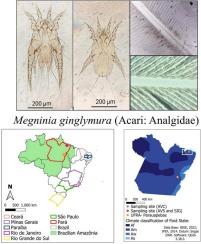巴西亚马逊地区帕尔州产蛋鸡中首次发现金线虫(蜱螨目:线虫科)
IF 1.4
Q3 PARASITOLOGY
Veterinary parasitology, regional studies and reports
Pub Date : 2025-07-13
DOI:10.1016/j.vprsr.2025.101318
引用次数: 0
摘要
毛螨(megniniia ginglymura)(螨亚纲:麻螨科)是一种分布广泛的羽螨。在南美洲,委内瑞拉和巴西的蛋鸡都有体外寄生的记录,后者的记录来自塞埃尔本文章由计算机程序翻译,如有差异,请以英文原文为准。

First occurrence of Megninia ginglymura (Acari: Analgidae) in laying hens in state of Pará, in the Amazon biome, Brazil
Megninia ginglymura (Mégnin) (Acari: Analgidae) is a widely distributed feather mite species. In South America, ectoparasitism have been documented in laying hens in Venezuela and Brazil, with records in the latter country from the states of Ceará, Paraíba, Minas Gerais, São Paulo, Rio de Janeiro, and Rio Grande do Sul. Between March and June 2024, were examined, monthly, feathers from Automated Vertical Climate System (AVC), Automated Vertical System (AVS) and Automated Californian System (SIG) in the northeastern region of the state of Pará, Brazil, in the Amazon biome. Megninia ginglymura were found on the feathers during the sampling period. Greater mite abundance was observed in abdomen, in the SIG and AVS, and in the cloaca, in AVC. Higher abundance of eggs was observed on the inner part of the wings, in the systems.
求助全文
通过发布文献求助,成功后即可免费获取论文全文。
去求助
来源期刊
CiteScore
2.90
自引率
7.10%
发文量
126
审稿时长
97 days
期刊介绍:
Veterinary Parasitology: Regional Studies and Reports focuses on aspects of veterinary parasitology that are of regional concern, which is especially important in this era of climate change and the rapid and often unconstrained travel of people and animals. Relative to regions, this journal will accept papers of the highest quality dealing with all aspects of disease prevention, pathology, treatment, epidemiology, and control of parasites within the field of veterinary medicine. Also, case reports will be considered as they add to information related to local disease and its control; such papers must be concise and represent appropriate medical intervention. Papers on veterinary parasitology from wildlife species are acceptable, but only if they relate to the practice of veterinary medicine. Studies on vector-borne bacterial and viral agents are suitable, but only if the paper deals with vector transmission of these organisms to domesticated animals. Studies dealing with parasite control by means of natural products, both in vivo and in vitro, are more suited for one of the many journals that now specialize in papers of this type. However, due to the regional nature of much of this research, submissions may be considered based upon a case being made by the author(s) to the Editor. Circumstances relating to animal experimentation must meet the International Guiding Principles for Biomedical Research Involving Animals as issued by the Council for International Organizations of Medical Sciences (obtainable from: Executive Secretary C.I.O.M.S., c/o W.H.O., Via Appia, CH-1211 Geneva 27, Switzerland).

 求助内容:
求助内容: 应助结果提醒方式:
应助结果提醒方式:


